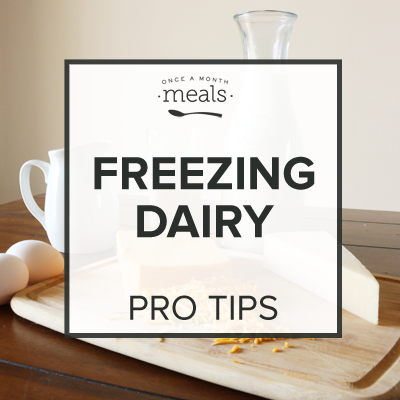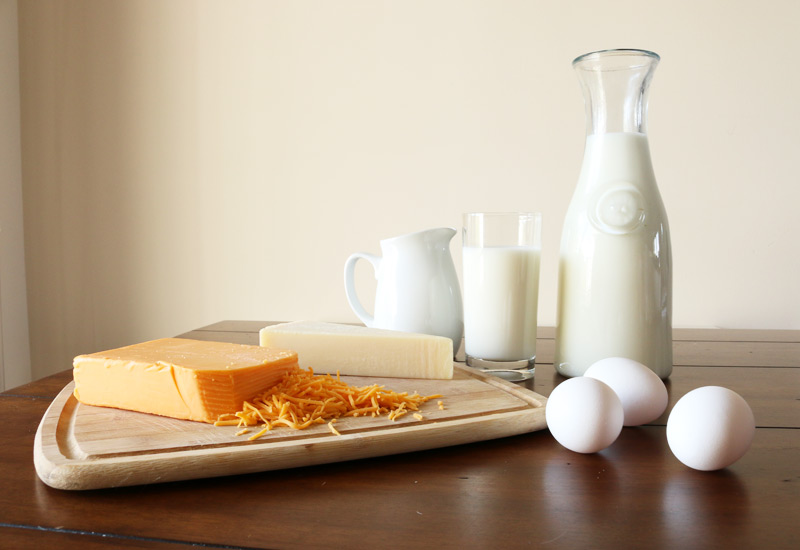
If you have perused through our Get Started series, you seen us discuss items you can and cannot freeze.
While we do follow all the rules that pertain to safely freezing and thawing foods, there are some “rules” that are really more recommendations as they pertain more to texture differences you’ll notice in the pre and post frozen product. For instance, with freezing dairy items, our rebellious, rule-bending selves show a little more as we incorporate products others likely would not, such as sour cream and cream cheese.
Since we tend to cook or bake with ingredients like these that might separate or be crumbly after thawing, we haven’t found any changes to them that make much if any, difference in the final dish.
In order to help you on cooking day, we have prepared some instructions for how to freeze dairy products without losing the great taste!
How to Freeze Dairy Products
There are a couple things worth noting before going on a dairy freezing frenzy.
- Items with a higher fat content generally fare better in the freezer than their lower-fat counterparts.
- Per the USDA Freezing and Food Safety Guidelines: “Food stored constantly at 0 °F will always be safe. Only the quality suffers from lengthy freezer storage.”
With that in mind, the timeframes mentioned in the sections below aren’t strict but general periods that aim to leave you with the best quality ingredient after thawing. If an item ever smells rancid or, in the case of typically white dairy items, looks yellowish you should dispose of the ingredient rather than use it.
Butter
You can portion larger blocks of butter into more convenient ¼ or ½ cup sections, wrap in plastic wrap and place in a freezer bag for storage in the freezer. When needed, move a section to the fridge to thaw for use. Unsalted butter is inclined to lose flavor so it is best used before 6 months in the freezer. Salted butter maintains it’s taste for longer so it can be frozen for up to 9 months before noticing a difference.

Milk & Cream
For milk, buttermilk, heavy whipping cream, half and half, etc. you can pour roughly a 1/2 inch of the liquid out of the plastic jug and freeze it in that lidded container. What you remove from the jug allows for the expansion space needed as the milk and cream freeze. You can also freeze these in smaller portions in ice cube trays, with about 2 Tablespoons per cube, or by the cup in lidded glass or plastic containers. The cubes can be moved to freezer bags after they are frozen for easy storage. Milk and cream are best used within 2 or 3 months in cooking and baking preparations.
After thawing in the fridge, you will need to shake or whisk the milk or cream to remedy any separation that takes place. Also, post freezing heavy whipping cream does not whip very well. So if you want to use it as a dessert topping, before freezing whip with some sweetener to desired consistency and place dollops on a lined baking sheet. Place the baking sheet in the freezer and once the dollops are frozen they can be moved to a freezer bag and stored until needed.
Cheeses
Before freezing cheese you will want to shred, slice or cube it as after thawing it can be rather crumbly. After you’ve processed your cheese to your liking, simply divide the it among freezer bags and use within 3 months for the best flavor and consistency. Thaw in the fridge when you are ready to use it for a big cooking day or another cheesy meal of your choice.
Ricotta, Cottage Cheese & Cream Cheese
These creamier cheeses can be frozen used within 2 months. Foil-wrapped cream cheese can be placed in a freezer bag for this longer-term storage and ricotta and cottage cheeses can be frozen in their containers. If you’d rather divide these into smaller portions like some of the earlier dairy items, this is certainly a possibility as well. For cream cheese, you will want to wrap the divided portions in plastic wrap before putting them in a freezer bag. The ricotta and cottage cheeses can be divided into a smaller glass or plastic lidded containers for freezer storage.
After these are thawed in the fridge, they do have a tendency to separate or become crumbly. Like earlier with the milk, you will need to stir or whisk these to help reincorporate them. Cream cheese, in particular, may also need a bit of low heat while slowly stirring to further encourage it to return to a consistency similar to before it was frozen. Overall once these cheeses are added into the dish you are cooking it will help as well.
Sour Cream & Yogurt
For sour cream and yogurt, you can freeze them in their plastic containers or divide them into a smaller glass or plastic lidded containers for storage as well. These will last 1 to 2 months in the freezer. Like some previous dairy items we’ve looked at, sour cream is also inclined to separate and get a little grainy so will need to be stirred and perhaps a bit of heat to return to a smoother state. Yogurt may get a touch grainy and need a stir as well. If you find you don’t care for the yogurt’s consistency on its own, using it in a smoothie is a quick and easy way to disguise any difference. Also, plain yogurt may taste a bit more acidic after freezing so adding some honey, like in our homemade freezable yogurt, or a little vanilla before freezing will help keep that at bay.
Eggs
While definitely not a dairy product, eggs are found in the dairy aisle and often lumped in with dairy items so we’ve included them here for that reason. Eggs can be frozen cooked or raw, just not in the shells. Raw eggs can be cracked into a glass or plastic lidded container for storage or you can even use an old ice cube tray to freeze egg whites or egg yolks separate for certain recipes. Once frozen, you can pop out the whites and yolks and place them in freezer bags. Eggs can be frozen for up to 12 months and thawed in the fridge as needed.
Hopefully, this information will help you out next time you are left with unused cream after a big freezer cooking day or come across a sale on your favorite butter or cheese. Armed with a few tips and tricks, you can stretch the life of your dairy ingredients as well as the reach of your budget.
Now that you’ve learned a few new tricks about freezing dairy, try our decadent homage to dairy with our Dessert Freezer Recipes Collection!
